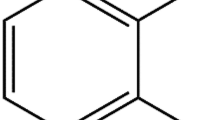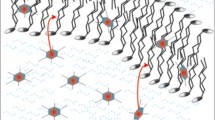Abstract
Although the interactions of sulfur mustard (HD) with nucleic acids and proteins have been well studied, the toxic interactions with the membrane matrix and specially the phospholipid bilayer have so far been poorly investigated. We have used several NMR techniques to study these interactions: 1H NMR to observe the localization of HD in membranes of small unilamellar vesicles (SUV) of lecithin; 31P NMR to verify the hypothesis of pore formation in membranes of large unilamellar vesicles (LUV); and pseudo solid state 31P and 2H NMR to analyze the dynamic consequences of the presence of HD in multilayer dispersions of dimyristoylphosphatidylcholine (DMPC). Immediate and late modifications of the DMPC–HD complexes have been observed at the macroscopic and microscopic levels.
After intoxication, HD is spontaneously incorporated into the membrane and locates at the level of the chain methylene groups. This incorporation occurs without formation of pores in the membrane. The presence of HD in the phospholipid dispersion differentially increases the membrane fluidity depending upon the level involved. Weak at the superficial level (phosphate group), this increase is dose-dependent on progression into the membrane. This increase is related to a lowering of transition temperature when measured at the chain level. Macroscopically, HD induces dose- and time-dependent modifications of the DMPC–HD complexes, leading to the formation of an optically transparent gel. This gel formation is confirmed at a microscopic level, where all structures disappear after intoxication.
Similar content being viewed by others
References
Andrzewski J, Scianovski J. Investigation of the toxic influence of sulfur yperite on selected internal rat organs and auto-tadiographic assays of its distribution in internal organs damaged earlier with sulfur yperite. Pathologia Polska 1978;29:51-60.
Blewett WK. Tactical weapons: is mustard still killing? NBC Defense Technology Int. 1986;1:64-6.
Bossane P, Heintz O, Fauvelle F, Baron D, Mariotte AM, Debouzy JC. Interaction of flavonoid extracted from plane-tree buds with membranes. Boll Chim Pharm. 1994;133: 401-5.
Casillas RP, Kiser RC, Babin MC, Smith WJ. In vivo modula-tion of cutaneous sulfur mustard (SM) injury with pharma-centicals. Congrè s NATO “Operational medical issues in chemical and biological defense'”. Lisbon, Portugal, 14-18 May 2001.
Dabouis V, Debouzy JC, Crouzy S, et al. Side-chain modifica-tions on anticancer pyrido[1,2-e]purines strongly influence their interactions with membranes. Boll Chim Pharm. 1999; 138:544-52.
Dacre, JC, Goldman M. Toxicology and pharmacology of the chemical warfare agent sulfur mustard. Pharmacol Rev. 1996;48:289-325.
Dahl H, Gluud B, Vangsteg P, Norn M. Eye lesions induced by mustard gas. Acta Ophtalmologica. 1985;63:30-1.
Debouzy JC. Etude des interactions drogues-membranes par RMN: application aux molécules d'ajoè ne, de l'amphotér-icine B et des phosphotriesters de nucléotides. (PhD thesis, Université Pierre et Marie Curie, Paris VI, 1989).
Debouzy JC, Fauvelle F, Vezin H, Brasme B, Chancerelle Y. Interaction of the malonyldialgehyde molecule with mem-branes, 1H, 31P and ESR study. Biochem Pharmacol. 1992; 44:1787-93.
Dufourcq, E.J. La résonance magnétique nucléaire du phos-phore et du deutérium dans les milieux organisés. Thè orie et application à l'étude de l'action de la mé litine et la delta lysine sur les membranes biologiques. (PhD thesis, Bor-deaux I, 1986).
Gentilhomme E, Neveux Y, Hua A, Thiriot C, Faure M, Thivolet J. Action of bis(betachloroethyl)sulphide (BCES) on human epidermis reconstituted in culture: morphologi-cal alterations and biochemical depletion of glutathione. Toxicol In Vitro. 1992;6:139-47.
Gorenstein D. Phosphorus 31P-NMR: principes and applica-tions. London: Academic Press; 1984.
Hackett PL, Rommereim RL, Burton FG, Buschbom RL, Sasser LB. Teratology study of lewisite and sulfur mustard agents. Final report, AD 187495. Richland, WA: Pacific Northwest Laboratory; 1987.
Hahn EL. Spin echoes. Phys Rev. 1950;80:580-91
Hay A, Robert G. The use of poison gas against the iraqi kurds: analysis of bomb fragments, soil, and wool samples. JAMA. 1990;263:1065-6.
Heintz O, Bossane P, Fauvelle F, Debouzy, JC. Interaction du 4-hydroxynonénane avec les systè mes membranaires. Ann Pharm Fr. 1995;53:24-8.
Henin Y, Gouyette C, Schwartz O, Debouzy JC, Neumann JM, Huynh-Dinh T. Lipophilic glycoyl phosphotriesters of AZT: synthesis, NMR transmembrane transport study and anti-viral activity. J Med Chem. 1991;34:1830-7.
Hervé M, Debouzy JC, Borowski E, Cybulska B, Gary-Bobo CM. The role of carboxyl and amino groups of polyene macrolides in their interactions with sterols and their selective toxicity: a 31P-NMR study. Biochim Biophys Acta. 1989;17:261-72.
Kurada Y, Wakita M, Nakagawa T. Interaction between dibu-caine and pig erythrocytes membranes as studied by NOESY experiments and 1H NMR spectroscopy. Bull Magn Res. 1996;15:93-4
Lohs K. Delayed toxic e¡ects of chemical warfare agents. A SIPRI monograph, Stokholm: SIPRI; 1975.
Macura S, Ernst RR. Elucidation of cross-relaxation in lipids by 2D-NMR. Mol Phys. 1980;41:95-117.
Manning KP, Skegg DCG, Stell PL, Doll R. Cancer of the larynx and other occupational hazards of mustard gas workers, Clin Otolaryngol. 1985;6:165-70.
Mavromoustakos T, Theodoropoulou E, Yang DP. The use of high resolution solid state NMR spectroscopy and DSc to study the interactions of anesthetic steroids with membrane. Biochim Biophys Acta. 1997;1328:65-71.
Neumann JM, Zachowski A, Tran-Dinh S, Devaux P. High resolution proton magneticresonance of sonicated phospho-lipids. Eur Biophys J. 1985;11:219-23.
Pruit BA. Treatment of cutaneous injury In: Proceeding of vesicant workshop, Columbia, MD. AD A188222, USAM-RICD-SP-87-03; 1987:39-43.
Rey R, Majerus J, Broomfield CA. Sulfur mustard induced alteration of intracellular free calcium and membrane fluidity in normal human epidermal keratinocytes. Proc. XIIth Int Pharm Congress, Montreal; 1994: P.22.3.26.
Roux M. Etude des interactions lipides-protéines par RMN. Contribution des lipides anioniques. (Thè se de doctorat d'Etat Paris VI, 1987).
Sasser LB, Cushing JA, Miller RA, Kalkwarf DR, Dacre JC. Two-generations reproduction study of sulfur mustard in rats, Reprod Toxicol. 1996;10:256-63.
Szoka F, Papahadjopoulos D. Procedure for preparation of liposomes with large aqueous space and high capture by reverse phase evaporation. Proc Natl Acad Sci USA. 1978; 73:3999-4002.
Wenzel TJ. NMR shift reagents. Boca Raton, FL: CRC Press; 1987.
Author information
Authors and Affiliations
Rights and permissions
About this article
Cite this article
Debouzy, J., Aous, S., Dabouis, V. et al. Phospholipid matrix as a target for sulfur mustard (HD): NMR study in model membrane systems. Cell Biol Toxicol 18, 397–408 (2002). https://doi.org/10.1023/A:1020815723009
Issue Date:
DOI: https://doi.org/10.1023/A:1020815723009




